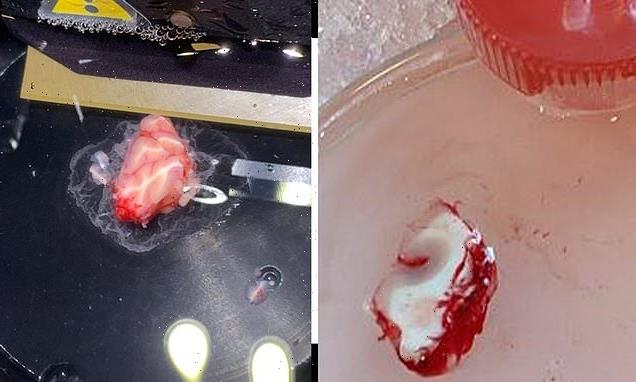
Slice of human BRAIN is kept alive in a petri dish for 12 hours in a breakthrough process that could help scientists study ways to treat fatal tumors and diseases
- A small piece from a human cortex was removed and kept alive for 12 hours
- Scientists cooled the removed piece and then placed it in a mixture similar to spinal fluid
- Scientists are working to keep a slice of living brain alive for 10 days
A one-centimeter slice of a human brain was kept alive in a petri dish for the first time, in a breakthrough study that will help find new drugs and treatments for fatal diseases.
Led by Emma Louise Louth with the University of Copenhagen, a group of scientists extracted a piece of brain tissue from a patient’s cortex and quickly began a new process to ensure it survived.
The team first cooled down the tissue, keeping it oxygenated so cells stayed alive, and then placed the small piece in a mixture ions and minerals – the same ingredients found in cerebral spinal fluid.
Louth shared in a press release that she and her team were able to keep the brain tissue alive for 12 hours, allowing for studies and experiments to be conducted that have only been possible with animals.
Scroll down for video
A one-centimeter slice of a human brain was kept alive in a petri dish for the first time, in a breakthrough study that will help find new drugs and treatments for fatal diseases
‘To borrow an analogy from another researcher: Mouse studies versus human studies are basically like looking at a Nokia 3310 when trying to repair an iPhone,’ Louth said in a statement.
‘They have the same basic functions – but there is much greater complexity in the human brain.
‘We even know that there are differences in the types of cells and the expression of certain receptors. Therefore, being able to test directly in human tissue is a unique opportunity.’
The first study focused on the dopamine-enhanced connections between neurons in humans and mice, which showed the neurotransmitter associated with reward strengthens the connections between neurons in the human brain.
The team first cooled down the tissue, keeping it oxygenated so cells stayed alive, and then placed the small piece in a mixture ions and minerals – the same ingredients found in cerebral spinal fluid
Knowing this could, according to Louth, lead to new treatment opportunities, for example in connection with rehabilitation after a stroke or other types of acute brain damage, where patients lose synaptic connections in the brain and need to form new ones.
“We’ve been given the opportunity to show that dopamine plays a different role in humans and mice,’ said Louth.
‘This is a really good example of how the effect of a drug or a neurotransmitter varies between species, and it highlights the importance of being able to test drugs directly on human tissue.
However, philosophical questions have been raised regarding the slicing and dicing of living human brain tissue, but Louth ensures it does not feel pain.
“Every emotion or thought must go through many parts of the brain,’ she said.
‘The piece we work on is the size of the outermost part of your thumb, and it’s no longer connected to other areas of the brain. I understand why people wonder whether the neurons in the petri dish have a memory, but it’s simply not possible.”
The research group is currently working on a method that can keep the small slices of brains alive for up to ten days.
Source: Read Full Article

